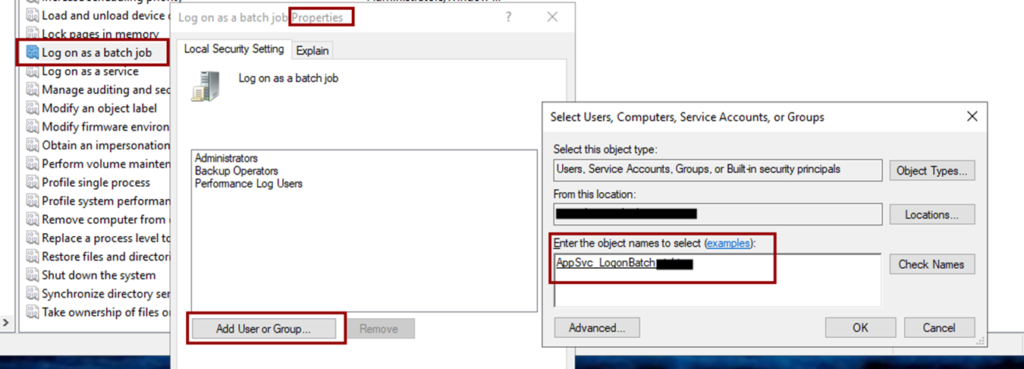This is Part 2 of my plan to set up SQL Monitoring between AWS accounts for a multi-company, multi-account enterprise.
To move the performance counter data around, we’ll need a User Service Account set up in Active Directory for this. Since I’m working with multiple companies I will need to duplicate this process in each domain.
I have set up a SERVICE ACCOUNT USER called SqlSsisUser. This AD USER is created in each and every company I will be gathering stats from, with only the domain name (and password) changing.
- 1stDomain\SqlSsisUser
- 2ndDomain\SqlSsisUser
- 3rdDomain\SqlSsisUser
Permissions granted to this user, include these groups:
- AWS Delegated Remote Access Service Administrator
- Domain Users (default group)
- Other GROUPS as needed, depending on your system.
- AppSvc_LogonBatch
NOTE 1: AppSvc_LogonBatch is a custom group that I will attach to the Local Policy on the main server, to allow the user to run PowerShell scripts.

On each EC2 Server that will be running PowerShell, I will need to configure the AD User to have LOGON AS A BATCH JOB permissions. Under WINDOWS ADMINISTRATIVE TOOLS, launch the LOCAL SECURITY POLICY. Under SECURITY SETTINGS / LOCAL POLICIES / USER RIGHTS AND ASSIGNMENTS, add the custom group as shown:


SQL Server Permissions
Add this new service account user (SqlSsisUser) to the SQL Server instance and configure at least these permissions on the databases: msdb, SSISDB, and ServerAnalysis (created in a later step.)


Create SQL Server Credential and Proxy
On each SQL Server instance, create a credential and proxy to SSIS for the service account user SqlSsisUser:
USE master;
CREATE CREDENTIAL [CRSqlSsisUser] WITH IDENTITY = N'MYDOMAIN\SqlSsisUser', SECRET=N'MyPASSWORD'
USE msdb;
EXEC dbo.sp_add_proxy
@proxy_name = 'SqlSsisUser proxy',
@enabled = 1,
@description = 'SSIS tasks on catalog.',
@credential_name = 'CRSqlSsisUser' ;
EXEC msdb.dbo.sp_grant_login_to_proxy
@proxy_name = N'SqlSsisUser proxy',
@login_name = N'MYDOMAIN\SqlSsisUser';
EXEC msdb.dbo.rds_sqlagent_proxy
@task_type = 'GRANT_SUBSYSTEM_ACCESS',
@proxy_name = 'SqlSsisUser proxy',
@proxy_subsystem = 'SSIS';
In the next step we’ll create the ServerAnalysis database(s) and objects.